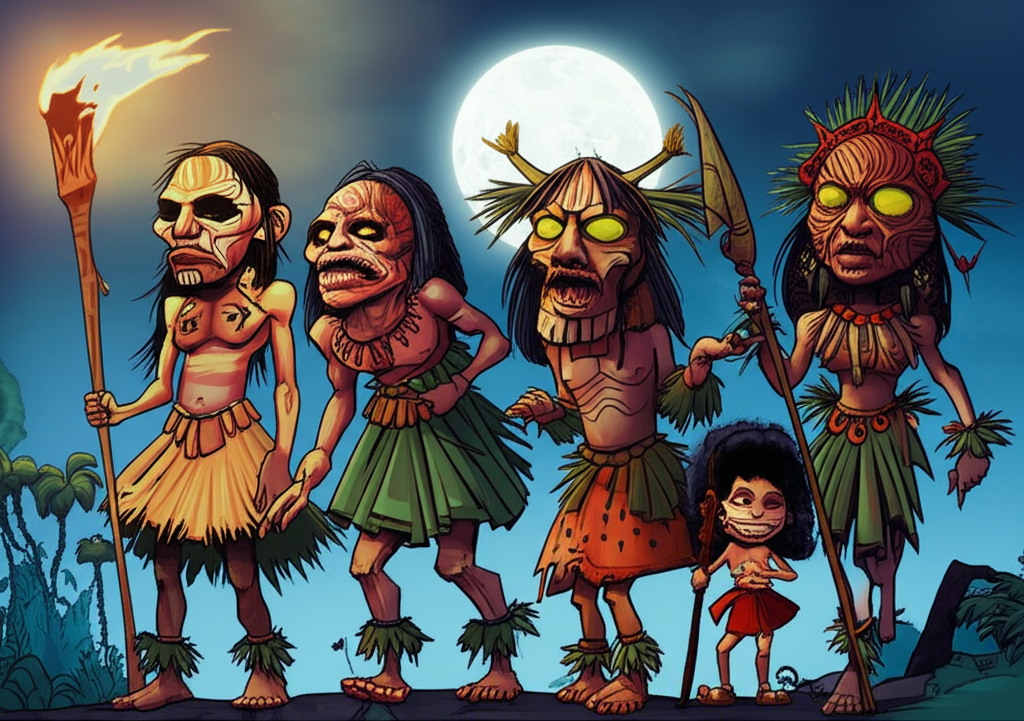
The islands of Samoa, emerald jewels scattered across the vast, sapphire expanse of the Pacific Ocean, hold within their verdant valleys and volcanic peaks a rich tapestry of ancient lore. Among these traditional stories, whispered through generations under the star-dusted canopy of the southern sky, are tales of the Nightmarchers, or Au aitu. These are not accounts of historical events or verifiable phenomena, but rather narratives woven from the collective imagination of the Polynesian people, a way for them to understand their world, their ancestors, and the mysteries that lay beyond the veil of everyday existence.
The myths of the Nightmarchers emerge from a time when the world was perceived as a place alive with unseen forces. In the early Samoan society, deeply connected to the rhythm of nature, the boundaries between the living and the departed were porous. The natural world – the crashing waves, the rustling palms, the volcanic fires – was imbued with spirit and power. Ancestors, particularly those of high status or great deeds, were believed to maintain a presence, their spirits capable of interacting with the mortal realm. This understanding shaped their worldview, where respect for the elder generations and the natural environment was paramount, and where the unknown was often personified through potent, often formidable, beings.
The Nightmarchers, in these ancient narratives, are depicted as spectral legions, the spirits of warriors and chiefs who once roamed the islands. They are not described as benevolent guardians, but rather as an imposing and often feared presence. Their appearance is typically associated with the deepest hours of the night, when the moon casts long, eerie shadows and the air grows still. They are said to march in orderly ranks, their forms dimly illuminated, their footsteps rustling through the undergrowth or echoing on the sandy shores. Their symbolic attributes are those of martial prowess and ancient authority. They are often portrayed as carrying torches that cast a flickering, otherworldly glow, their voices a low, resonant murmur that can send shivers down the spine. The imagery evokes a sense of formidable power, of a force that commands respect and demands caution. These are not merely ghosts, but the organized, spectral remnants of a society’s most esteemed warriors, their essence still bound to the lands they once protected or conquered.
The narrative of the Nightmarchers often unfolds in hushed tones, shared around crackling fires as the ocean whispers its ancient secrets to the shore. Imagine a tranquil Samoan night, the air thick with the scent of frangipani and the distant roar of the surf. Suddenly, a strange sound begins to emanate from the dense jungle – a rhythmic thudding, a faint, ethereal chanting, and the distinct clinking of what sounds like weaponry. The villagers, huddled in their homes, would instinctively know what it signifies. The Nightmarchers are on the move.
The story might tell of a young man, perhaps a curious or impetuous soul, who has ventured out too late, straying from the safety of his village. As the sounds grow closer, a chilling dread would creep into his heart. He might catch glimpses of them – shadowy figures, their eyes like embers in the darkness, their bodies indistinct, yet undeniably present. The legend warns that to see them is a perilous omen. If you are seen by the Nightmarchers, you are expected to avert your gaze immediately, to fall to your knees, and to remain absolutely still. Any movement, any attempt to flee, is said to invite their wrath. The narrative emphasizes the absolute stillness required, the ultimate surrender to their spectral passage. Some tales speak of those who dared to challenge or mock them, only to be swept away by an unseen force, their lives tragically extinguished, their spirits perhaps joining the spectral ranks. The sound of their march, the story would convey, is a reminder of the powerful forces that govern the night, a testament to the enduring legacy of those who came before.
The symbolism embedded within the Nightmarcher myth is multifaceted. Primarily, it served as a potent representation of the power and presence of ancestors. For the ancient Samoans, the line between the living and the dead was not a definitive barrier, and the Nightmarchers embodied this continuous connection. Their nightly processions could be interpreted as a reminder of the ancestral realm’s watchfulness, a subtle assertion of their continued influence over the mortal world. They might also represent the fear of the unknown, the primal apprehension that arises in the darkness. The organized, inexorable march of the Nightmarchers could symbolize the inevitability of certain forces, be it the passage of time, the cycle of life and death, or the consequences of disrespecting ancient traditions. Furthermore, the tales of their martial bearing could reflect the cultural importance placed on warfare, bravery, and the legacy of warrior chiefs, ensuring that their prowess, even in spectral form, remained a significant part of the cultural memory.
In the modern era, these ancient tales continue to resonate, finding new life in various forms of creative expression. The Nightmarchers have been reimagined in literature, often as formidable supernatural antagonists in stories set in the Pacific. They have appeared in video games, their spectral ranks and otherworldly presence lending themselves to thrilling and challenging encounters. In film and television, they can be depicted as figures of mystery and dread, their ancient origins adding a layer of cultural depth to supernatural narratives. Beyond entertainment, these myths are invaluable for cultural studies, offering insights into the spiritual beliefs, social structures, and worldview of ancient Polynesian societies. They are a testament to the enduring power of oral tradition and the human need to explore the mysteries of existence through storytelling.
It is important to reiterate that the narratives of the Nightmarchers are traditional stories, born from the cultural and imaginative landscapes of ancient peoples. They are not to be believed as factual accounts, nor are they intended for worship or practice. As Muslims, we recognize that the true Creator and Sustainer of all existence is Allah (SWT), and that all power and authority reside with Him alone. These myths, therefore, are understood within the context of their cultural heritage, as fascinating expressions of human imagination and the storytelling tradition. They offer a glimpse into the ways in which past generations sought to understand their world, their fears, and their connection to the unseen. The echoes of Hina and the spectral march of the Nightmarchers, in this light, are not signs of divine power but rather a testament to the rich tapestry of human culture and the enduring legacy of our ancestors’ stories.





